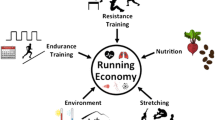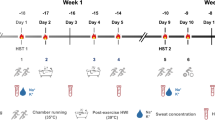Abstract
In a study on 53 healthy male volunteers with the use of an infrared thermograph, data that the thermal portrait, i.e., skin temperature distribution, under the conditions of muscular rest and minimal chemical thermoregulation activation is related to the maximal aerobic capacity (r = + 0.6) and the lactate level after critical muscle load (r = −0.7) were obtained. A series of pilot experiments on six volunteers showed that acute regional cooling (by placing feet into ice-cold water for 1 min) led to temperature rise in some local areas of the breast and back skin and increase in oxygen uptake, pulmonary ventilation and the respiratory quotient. Simultaneously, the lactate level in peripheral blood was reduced. On the basis of these results, it was assumed that brown adipose tissue (BAT) activity influenced the thermal portrait formation in the case of environmental temperature below thermoneutral. This hypothesis makes it possible to explain a negative correlation between the skin temperature and the body mass index and a twofold increase in the oxygen uptake during acute cold exposure. Nevertheless, further investigations are necessary to clarify the physiological mechanisms underlying the significant correlation between skin temperatures at rest under thermoneutral conditions and the maximal aerobic capacity, anaerobic threshold and lactate accumulation after critical muscle load.
Similar content being viewed by others
References
Kolesov, S.N., Osteokhondroz pozvonochnika: nevrologicheskie i teplovizionnye sindromy. (Osteochondrosis of the Vertebral Column, Neurologic and Thermal Syndromes), Nizhni Novgorod, 2006.
Akimov, E.B., Andreev, R.S., Arkov, V.V., Kirdin, A.A., Saryac, V.V., Sonkin, V.D., and Tonevitsky, A.G., Thermal “Portrait” of Sportsmen with Different Aerobic Capacity, Acta Kinesiol. Univ. Tartuensis, 2009, vol. 14, p. 7.
Ferreira, J.J., Mendonça, L.C., Nunes, L.A., Andrade, Filho A.C., Rebelatto, J.R., and Salvini, T.F., Exercise-Associated Thermographic Changes in Young and Elderly Subjects, Ann. Biomed. Eng., 2008, vol. 36, no. 8, p. 1420.
Merla, A., Tangherlini, A., Iodice, P., Michele, G.D., Romualdo, S. D., Saggini, R., and Romani, G.L:. Monitoring Skin Temperature in Trained and Untrained Subjects throughout Thermal Video, in Proc. 27th Annual Int. Conference EMBS, Shanghai, 2005, p. 1684.
Zontak, A., Sideman S., Verbitsky, O., and Beyar, R., Dynamic Thermography: Analysis of Hand Temperature During Exercise, Ann. Biomed. Eng., 1998, vol. 26, p. 988.
Clark, R.P., Mullan, B.J., and Pugh, L.G. Skin Temperature during Running: A Study Using Infrared Color Thermography, J. Phisiol., 1977, vol. 267, p. 53.
Medvedev, L.N. and Elsukova, E.I., Human Brown Adipose Tissue, Usp. Fiziol. Nauk, 2002, vol. 33, no. 2, p. 17.
Nedergaard, J., Bengtsson, T., and Cannon, B., Unexpected Evidence for Active Brown Adipose Tissue in Adult Humans, Am. J. Physiol. Endocrinol. Metab., 2007, vol. 293, p. E444.
Son’kin, V.D., Zaitseva, V.V., Kozlovskaya, I.B., Bayevsky, R.M., and Tchernikova, A.G., Interrelation of Cosmonaut Muscle Working Capacity and Autonomous Regulation Indices During Long-Term Flight, in Abstr. 23rd Annual ISGP Meeting and 8th TSE Life Sciences Symposium, Stockholm, 2002.
Rodionov, I.M., Sympathetic Influences on Skeletal Muscle Working Capacity, Usp. Fiziol. Nauk, 1979, vol. 10, no. 4, p. 52.
Ivanov, K.P., Osnovy energetiki organizma, vol. 1: Obshchaya energetika, teploobmen i termoregulyatsiya (Principles of Energetics of the Living Body, vol. 1: General Energetics, Heat Exchange, and Thermoregulation), Leningrad: Nauka, 1990.
Lehninger, A.Z., Bioenergetics: The Molecular Basis of Biological Energy Transformations, New York: Benjamin, 1965.
Demin, V.I., Kornienko, I.A., Maslova, G.M., et al., Organization Particularities of Energy Methabolism in Different Organs, in Molekulyarnye mekhanizmy i regulyatsiya energeticheskogo obmena (Molecular Mechanisms and Regulation of Energy Exchange), Pushchino, 1987, p. 174.
Kornienko, I.A., Vozrastnye izmeneniya energeticheskogo obmena i termoregulatsii (Age-Related Changes in Energy Metabolism and Thermoregulation), Moscow: Nauka, 1979.
Skulachev, V.P., A Risky Job: In Search of Noncanonical Pathways, in Selected Topics in the History of Biochemistry: Personal Recollections VII, Semenza, G. and Turner, A.J., Eds., Comprehensive Biochemistry, 2003, vol. 42, chapter 7, p. 319.
Himms-Hagen, J., Brown Adipose Tissue Thermogenesis: Interdisciplinary Studies, FASEB J., 1990, vol. 4, no. 11, p. 2890.
Astrup, A., Thermogenesis in Human Brown Adipose Tissue and Skeletal Muscle Induced by Sympathomimetic Stimulation, Acta Endocrinol. Suppl. (Copenh.), 1986, vol. 278, p. 1.
van Marken, L., Vanhommerig, J.W., Smulders, N.M., et al., Cold-Activated Brown Adipose Tissue in Healthy Men, N. Engl. J. Med., 2009, vol. 360, no. 18, p. 1500.
Cypess, A.M., Lehman, S., Williams, G., et al., Identification and Importance of Brown Adipose Tissue in Adult Humans, N. Engl. J. Med., 2009, vol. 360, no. 15, p. 1509.
Cioffi, F., Senese, R., de Lange, P., Goglia, F., Lanni, A., and Lombardi, A., Uncoupling Proteins: A Complex Journey to Function Discovery, Biofactors, 2009, vol. 35, no. 5, p. 417.
Avram, A.S., Avram, M.M., and James, W.D., Subcutaneous Fat in Normal and Diseased States: 2. Anatomy and Physiology of White and Brown Adipose Tissue, J. Am. Acad. Dermatol., 2005, vol. 53, no. 4, p. 671.
Himms-Hagen, J., Role of Thermogenesis in the Regulation of Energy Balance in Relation To Obesity, Can. J. Physiol. Pharmacol., 1989, vol. 67, no. 4, p. 394.
Jequier, E., Thermogenic Responses Induced by Nutrients in Man: Their Importance in Energy Balance Regulation, Experientia Suppl., 1983, vol. 44, p. 26.
Crisan, M., Casteilla, L., Lehr, L., et al., A Reservoir of Brown Adipocyte Progenitors in Human Skeletal Muscle, Stem Cells, 2008, vol. 26, p. 2425.
Wijers, S., Saris, W., and van Marken, L.W.D., Individual Thermogenic Responses to Mild Cold and Overfeeding Are Closely Related, J. Clin. Endocrinol. Metab., 2007, vol. 92, no. 11, p. 4299.
Chelovek: mediko-biologicheskie dannye: Doklad rabochei gruppy komiteta 2 MKRZ po uslovnomu cheloveku (Humans: Biomedical Data: A Report of the Working Group of ICRP Committee 2 on a Conventional Average Human), Moscow: Meditsina, 1977.
Astrand, P.-O. and Wolffe, J.B., Memorial Lecture: “Why Exercise?”, Med. Sci. Sports Exerc., 1992, vol. 24, no. 2, p. 153.
Virtanen, K.A., Lidell, M.E., Orava, J., et al., Functional Brown Adipose Tissue in Healthy Adults, N. Eng. J. Med., 2009, vol. 360, no. 18, p. 1518.
Lopez-Soriano, F.J., Fernandez-Lopez, J.A., Mampel, T., Villarroya, F., Iglesias, R., and Alemany, M., Amino Acid and Glucose Uptake by Rat Brown Adipose Tissue: Effect of Cold-Exposure and Acclimation, Biochem. J., 1988, vol. 252, p. 843.
Ebner, S., Burnol, A.-F., Ferre, P., De Saintaurin, M.-A., and Girard, J., Effects of Insulin and Norepinephrine on Glucose Transport and Metabolism in Rat Brown Adipocytes: Potentiation by Insulin of Norepinephrine-Induced Glucose Oxidation, Eur. J. Biochem., 1987, vol. 170, p. 469.
Maslova, G.M. and Kornienko, I.A., Oxidative Metabolism and Changes in Cytochrome Oxydase Amount in Different Tissues in Postnatal Ontogeny, in Trudy 9 Nauchn. Konf. po Vozrastnoi Morfologii, Fiziologii i Biokhimii (Proc. 9th Scientific Conference on Developmental Morphology, Physiology, and Biochemistry), Moscow, 1969, part 1, p. 455.
Author information
Authors and Affiliations
Additional information
Original Russian Text © E.B. Akimov, R.S. Andreev, Yu.N. Kalenov, A.A. Kirdin, V.D. Son’kin, A.G. Tonevitsky, 2010, published in Fiziologiya Cheloveka, 2010, Vol. 36, No. 4, pp. 89–101.
Rights and permissions
About this article
Cite this article
Akimov, E.B., Andreev, R.S., Kalenov, Y.N. et al. The human thermal portrait and its relations with aerobic working capacity and the blood lactate level. Hum Physiol 36, 447–456 (2010). https://doi.org/10.1134/S0362119710040109
Received:
Published:
Issue Date:
DOI: https://doi.org/10.1134/S0362119710040109




